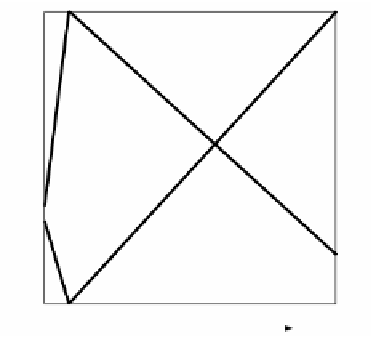Environmental Engineering Reference
In-Depth Information
occurs at an infi
nite reaction rate, it proceeds according to the stoichiometric rela-
tionship until one of the deficit species, fuel or oxygen, is consumed. Accordingly,
as shown in
Figure 3.2
, t
he flame front corresponds to the position where the value
of mixture fraction conforms to the stoichiometric ratio,
f
, and no fuel and oxygen
st
will remain there. Figure 3.2 is also a schematic illustration of adiabatic temperature
of combustion in terms of
, assuming complete combustion. By application of the
model, the theoretical adiabatic temperature in complete combustion is calculated
based on the enthalpy balance. The estimated combustion temperature, therefore,
implicitly infers the use of ambient air, hence 21% oxygen content, and tends to be
considerably higher than that usually measured in real furnaces. Also, whereas
combustion temperature can easily be calculated in an adiabatic system, it is hard
to define the temperature under a condition where there is heat transfer or heat loss.
The effect of turbulence is usually considered by the introduction of prescribed
probability density function (PDF) for the fluctuations of mixture fraction, that is,
clipped Gaussian distribution or
f
-function, for example. However complicated the
reaction models may be, the basic quantitative correlation between mixture fraction
and temperature is still dependent on the diagram in Figure 3.2, in which the
assumptions of adiabatic conditions and of ambient air are essential. Accordingly,
the combustion in high temperature air diluted with flue gas in the furnace, the most
important and influential factor of HiTAC, cannot be expressed by the diagram. The
local reaction rate of HiTAC differs depending on the local concentration of oxygen
as well as the local temperature lowered owing to heat transfer and heat loss.
β
3.1.2.3
Eddy-Break-Up Model
When comb
ustion occurs in a homogeneous mixture, it can be assumed that com-
bustion is governed by the reaction rate. However, in non-premixed combustion in
real furnaces where fuel and air are supplied separately, it is thought that the
1
T
f
T
ad
T
a
T
ad
m
fu
m
ox
T
f
T
ad
0
f
st
1
f
FIGURE 3.2
Adiabatic temperature and mass fractions of remaining fuel and oxygen in
terms of mixture fraction based on the mixing-is-reacted model.





Search WWH ::

Custom Search